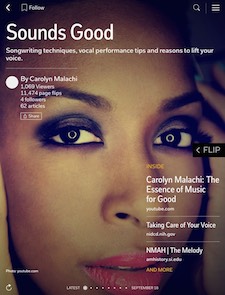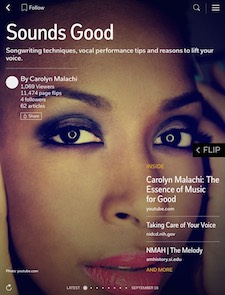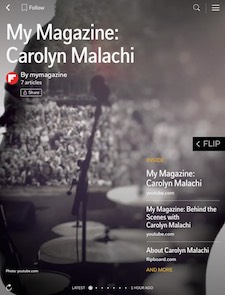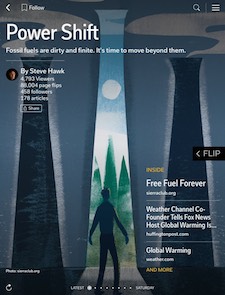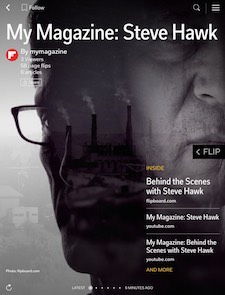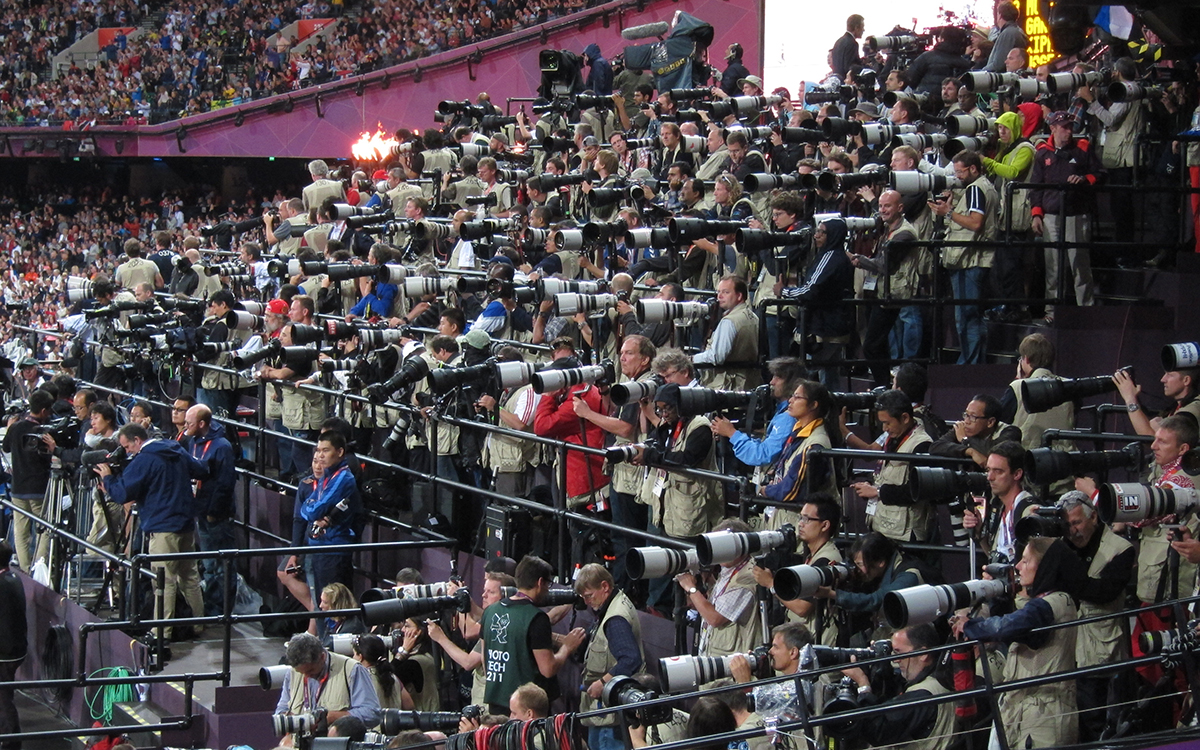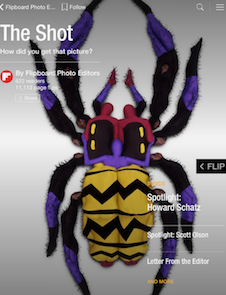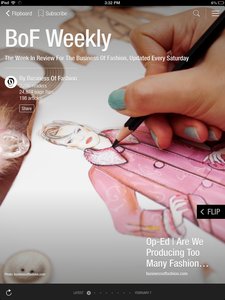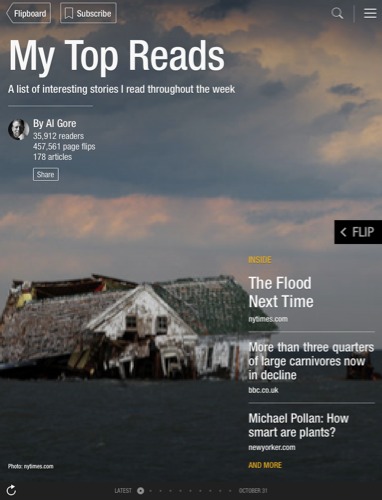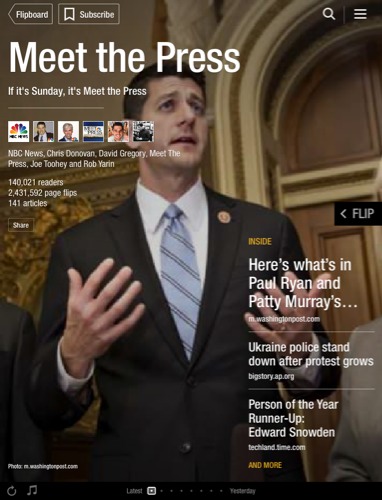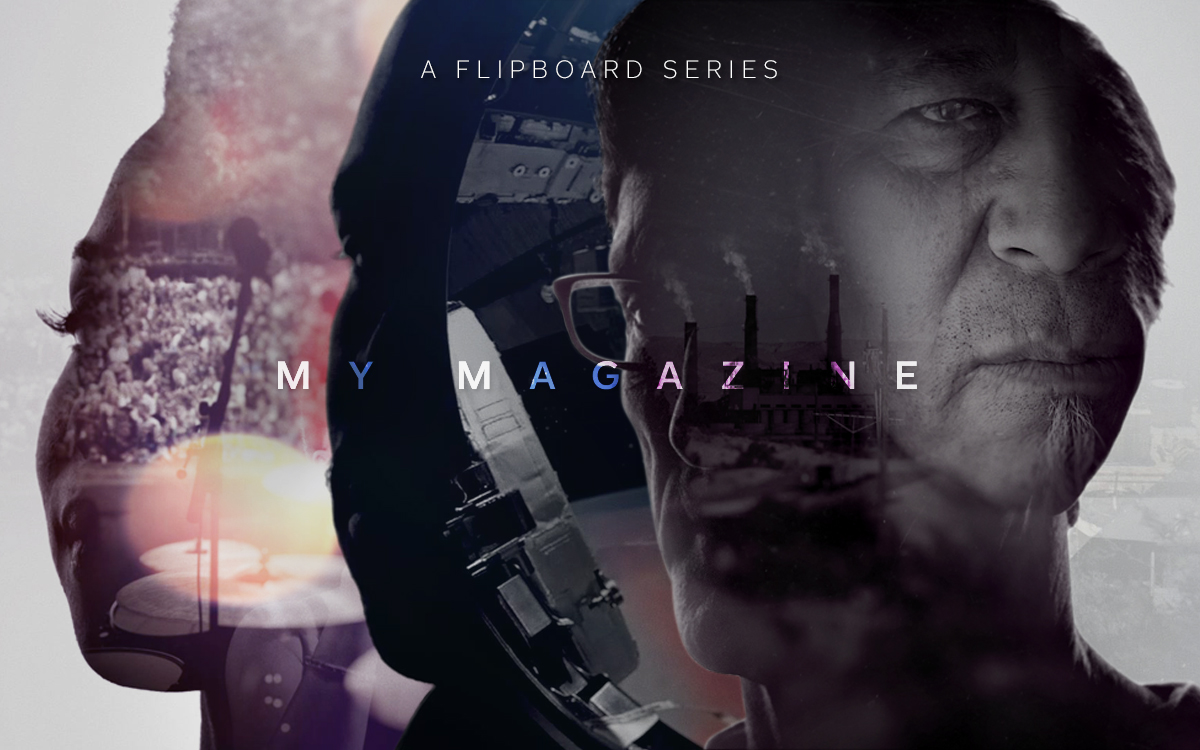
Over 10 million—that’s how many magazines our community has created since March 2013, when the feature launched. Now anyone can curate magazines focused on the things they care about most. But a nagging question has always been: how do you find these amazing collections, which cover everything from adaptive urbanism to zen running?
Today’s launch of the third generation of Flipboard includes a key new feature—Topics—that will help many of those magazines find the audiences they deserve. Search for a topic of interest, and the results will include content from magazines curated by people passionate about that subject. In other words: magazine makers will move into the spotlight on Flipboard as never before.
With that in mind, we’re highlighting some particularly moving curators/storytellers for a new video series called “My Magazine.” At a key moment in their life—some extraordinary, some seemingly mundane—they identified their passion and then made it their mission to share that with the world. They’ve also transferred that expertise and enthusiasm into Flipboard magazines.
Former NFL-player-turned-astronaut Leland Melvin‘s story could be summed up in two words: “second chances.” His position as a wide receiver for the Detroit Lions was well deserved, but back-to-back hamstring injuries put him on the bench for good—so he went the only direction he knew: literally up and away, all the way to outer space and later as a champion for S.T.E.A.M. (science, technology, engineering, art and math) education.
In Carolyn Malachi‘s case, it was music that moved her—not just to dance, but to tell her own truth. Despite having a famous jazz pianist for a great-grandfather, Malachi was nudged by her parents towards business school. As a born leader, it seemed like a perfect fit. Today she’s a Grammy-nominated singer and songwriter whose music acts as a way to trade stories, morals and mythologies about who we are.
And then there’s Steve Hawk, older brother to pro skater Tony Hawk, and no less accomplished. A journalist and lifelong surfer (one of the few people to have ridden waves on all seven continents), Hawk has translated his love of the ocean to readers of Harper’s, The New York Times and Outside Magazine, positioning surfing as the thinking man’s sport. Today he’s the executive editor at Sierra Magazine and acts as Secretary for the Tony Hawk Foundation, a charity focused on youth empowerment.
How about you? What’s your passion and are you using Flipboard magazines to share your expertise and interests with the world? We’d love to hear from you using the #mymagazine hashtag on social media, or upload your own inspiring video as a response to these videos on YouTube, Vimeo and/or Vine.
~ShonaS is curating “Proof of Experience”
/flipboard
@flipboard
+flipboard
It took three decades for Joseph Nicéphore Niépce to take the world’s first photograph: a black-and-white grainy image of his country-home courtyard, in 1826.
The photography world has rapidly developed since that maiden image, “View from the Window at Le Gras,” was shown, and now includes everything from Papal selfies to images from space. But in some ways, professional photography is as complex as ever. Deciding what type of gear, technique or software to use can daunt even the most avid camera enthusiast.
That’s why Flipboard’s photo editors, Steve Fine and Gary Hershorn, are teaming up to provide the ultimate take on all things photography: The Shot, a Flipboard magazine updated weekly. The magazine opens with Spotlight, which profiles professional photographers and their work. Additionally, each issue will feature the best photography from the Web and Instagram, along with behind-the-scenes reports from the photo wire services. Fine and Hershorn, storied photo editors from Sports Illustrated and Reuters, respectively, will also highlight the best galleries and images from publishers such as National Geographic and the Guardian and from among our users’ photo magazines. Finally, they’ll share articles about the best gear, tips and tricks they find.
Tap the cover the below to get started and hit the follow icon to never miss an update.
~NajibA is curating “Neat Stuff”
/flipboard
@flipboard
+flipboard
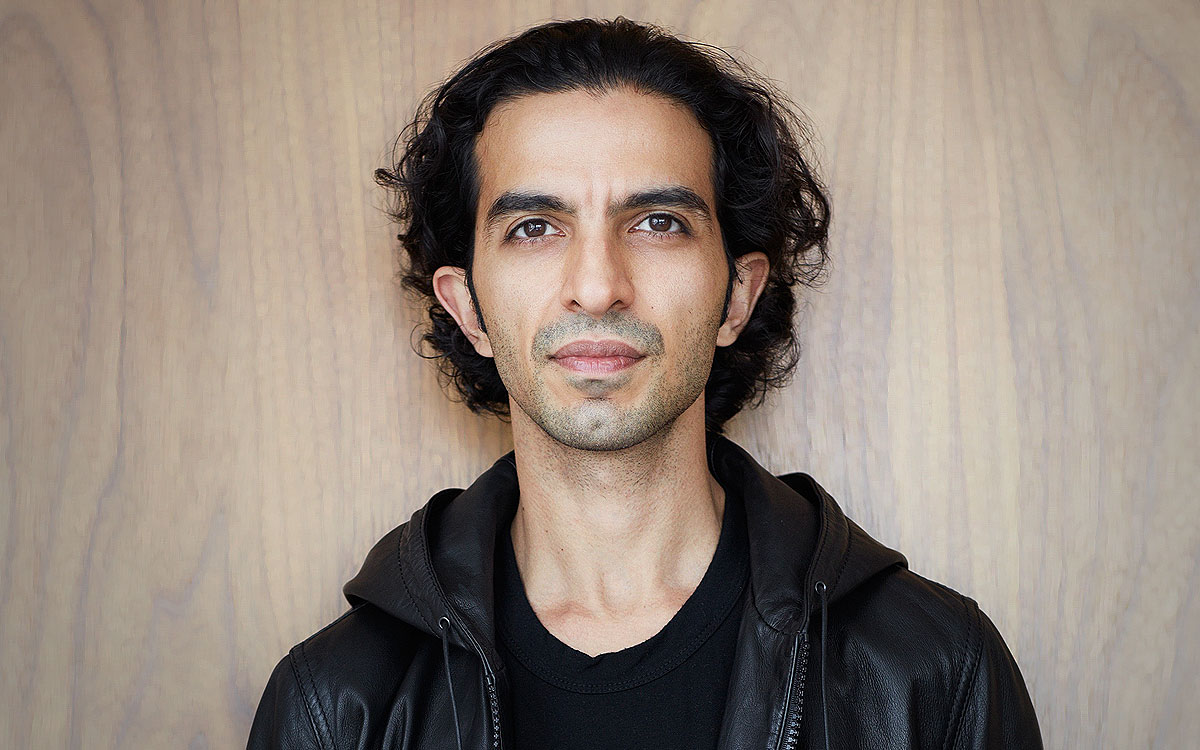
Imran Amed was a management consultant who wanted to apply his analytical skills to a creative field, and saw a hole in the fashion industry that he thought he could sew up. So he looked beyond the bubbly and beautiful people and, from his couch in the evenings, started writing about the big, global, powerful business of fashion.
Today, his site is a go-to resource for news and analysis on fashion’s creatives, executives, deals and entrepreneurs. It’s even been called “The Economist of Fashion“—a pretty sweet moniker for a publication started by someone with no previous experience in what is already a tight-knit community.
We chatted with Amed from his London office and found out just how this infiltration happened, how technology is changing fashion, which social platforms curry favor with fashionistas these days, and his secret spot for the best street style. The Business of Fashion team also curates a weekly magazine on Flipboard recapping noteworthy news of the week, as well as a magazine called The Spotlight, which showcases emerging designers.
Since you were new to the industry, what kinds of things did you have to learn quickly?
I didn’t know very much about the industry at all. But very early on I learned that basically everybody knows everyone. I treated every interaction with every person to be a really important, special interaction, and an opportunity to learn.
One of the things I’ve kept from my time at McKinsey is operating like a professional: doing what you say, treating everyone with respect, operating with integrity, and apologizing when you make a mistake. I really tried to apply these values into the way that I operate, and over time I think people began to respect that, even if I was an outsider.
What is the Business of Fashion? For example, what are some of the key issues the industry is facing and how has that changed over the years, especially with technology?
Because this industry has a physical product, it wasn’t as easily disrupted as, say, the music industry. There was no MP3 version of a Céline bag. But, over time, technology has really just disrupted the communication part of fashion and the commercial/transactional side of the industry. So whereas the products are still physical, everything around the engagement with the consumer has really been disrupted: the way consumers discover and discuss fashion, the way they learn about brands, the way they make purchases. All of that has really transformed.
I mean, the fact that you can now be a part of a fashion show experience as it’s happening — that was once something that was reserved for only a very few people who are part of the core elite of the industry. Some of the smallest fashion shows only have 200 people in the world who get to go to them.
All of a sudden these kinds of images were being beamed out to the universe and consumers all over the world were able to participate, comment on, and discuss these shows. And the fact that you can buy £5,000 handbags on your mobile phone and the next day have them show up at your door…I mean, all of this was unheard of.
What are some of the themes that you think are going to be prominent in 2014?
I just moderated a panel at DLD in Munich, which is a big tech conference that kind of kicks off the year and we were talking a lot about omni-channel commerce: this idea that mobile technologies enable consumers to have all of the information that they want about a product in the palm of their hands. Even if they’re shopping in a physical store, they’re able to do price or product comparisons with the same product or similar products available elsewhere or available online.
This idea of a kind of connected consumer who has all this information at their fingertips, 24 hours a day, really means that brands have to step up their game because the way someone discovers and purchases a product now might be that they see something in their Instagram feed and then they might go research it on the Internet, decide to go look at it in a store and then purchase it somewhere else later. So the consumer journey is spread out across so many different channels and being able to connect with the consumer in all of those channels is, I think, going to be a really important theme for the industry this year.
Instagram seems to be one of the main channels of discovery for anyone interested in fashion these days.
Yeah, I mean the fashion industry, as you may know, rejected or resisted social media when Facebook first emerged on the scene, and there were a lot of people who swore to me that they would never use social media. That was until Instagram came along. There’s something about the visual nature of Instagram, the simplicity of the user experience, and the ability to have a conversation around images…I’ve never seen the industry embrace a social media platform like they have embraced Instagram. It’s pretty remarkable.
And how is the industry dealing with the upsurgence of “user experts,” how someone with not a lot of traditional experience can become a prominent blogger of his or her own volition and hard work? How are they dealing with that?
It’s interesting because the first social media that I think the industry really embraced was the blog. Fashion is an industry that communicates in words and moving images and writing, and that was in a way the easiest format of social media that the industry could understand . I think those kinds of platforms have certainly provided an opportunity for previously unknown individuals to showcase their eye or their talent or their way with prose or their point of view and it’s been kind of amazing to see individuals who, you know, had no business being around the fashion world all of a sudden become very prominent, as you call them, user experts. At this stage, we don’t even distinguish between a high profile blog and the mainstream media—they’re all part of a fashion process; it’s just a new channel that the industry has at its disposal to have a conversation with consumers.
Who or what do you personally love to read?
I’m a pretty voracious consumer of media, not just fashion media, mind you, but media from the world of technology and business, and other things that I think are just great writing. Most of the media I consume comes to me in my Facebook page or through my Twitter feed, or through my Flipboard exploration. I actually use Flipboard to follow my Twitter feed because it’s so visual and beautiful. I follow everyone from The Economist and Bloomberg BusinessWeek to V Magazine to Wired and TechCrunch.
That’s a lot to keep up with. How do you unplug?
Meditation — about seven or eight years ago I did a meditation course called Vipassana meditation, which is a pretty intense, 10-day silent meditation and if I’m feeling like I need to unplug or manage stress or anxiety or sleeplessness then meditation is usually my first point of call. Also, just having regular time where I’m not engaging with my phone and having fun with my trainer at the gym — there’s no phone. It’s really important to be able to just keep that stuff away. And I take holidays. Over the Christmas break I was in Goa in India and I managed to properly switch off for a couple of weeks.
Is there a city that you think is sort of a hidden secret when it comes to amazing fashion, street style specifically?
Montreal. I went to university in Montreal. I would say I even caught the fashion bug first in Montreal because that city just exudes a certain sense of style that is really hard to find anywhere in the world. People there are really individual about the way they dress; they’re really confident and bold about the way they express themselves through clothing.
~MiaQ is reading “N.I.C.E. Design”
/flipboard
@flipboard
+flipboard
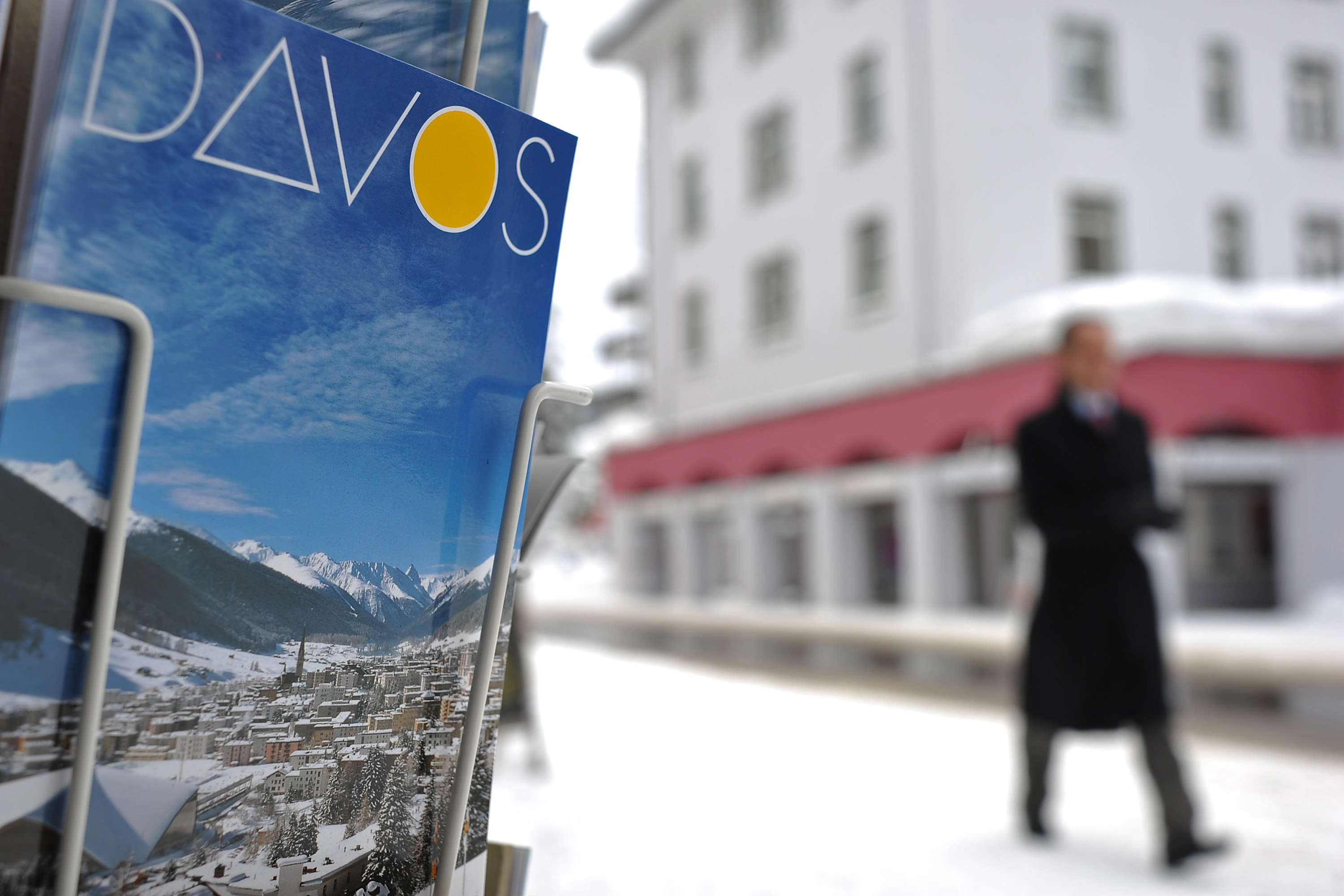
In the world of business conferences, it doesn’t get any more global than the annual World Economic Forum, in Davos, Switzerland. This week, its roster of more than 40 country leaders and business icons included David Cameron, Kofi Annan, Shinzo Abe, Marissa Mayer, Eric Schmidt, and Bill Gates.
A wide range of topics were discussed, as usual; this year, the main topics were income inequality, economic growth and climate change. At Flipboard, our far-flung magazine makers curated their own dossiers from a variety of sources that covered the summit. Here are a few of our favorites:
My Top Reads by Al Gore: Former Vice President Al Gore’s collection of articles about climate change and the environment.
Davos 2014 by Estelle Metayer: An excellent roundup of headlines and discussions.
2014 World Economic Forum by thenewsdesk: Must-read news from the Forum.
SILENT WITNESS TO WORLD POVERTY by Robert De Mayo Dillon: This magazine is focused on world poverty as well as poverty issues discussed at the WEF
Income inequality and its effects by ez040178: Highlighting one of this year’s key themes, this magazine spotlights the growing concern of income inequality
What’s your favorite magazine? Let us know by sending an email to featured@flipboard.com.
~YasukoK
/flipboard
@flipboard
+flipboard
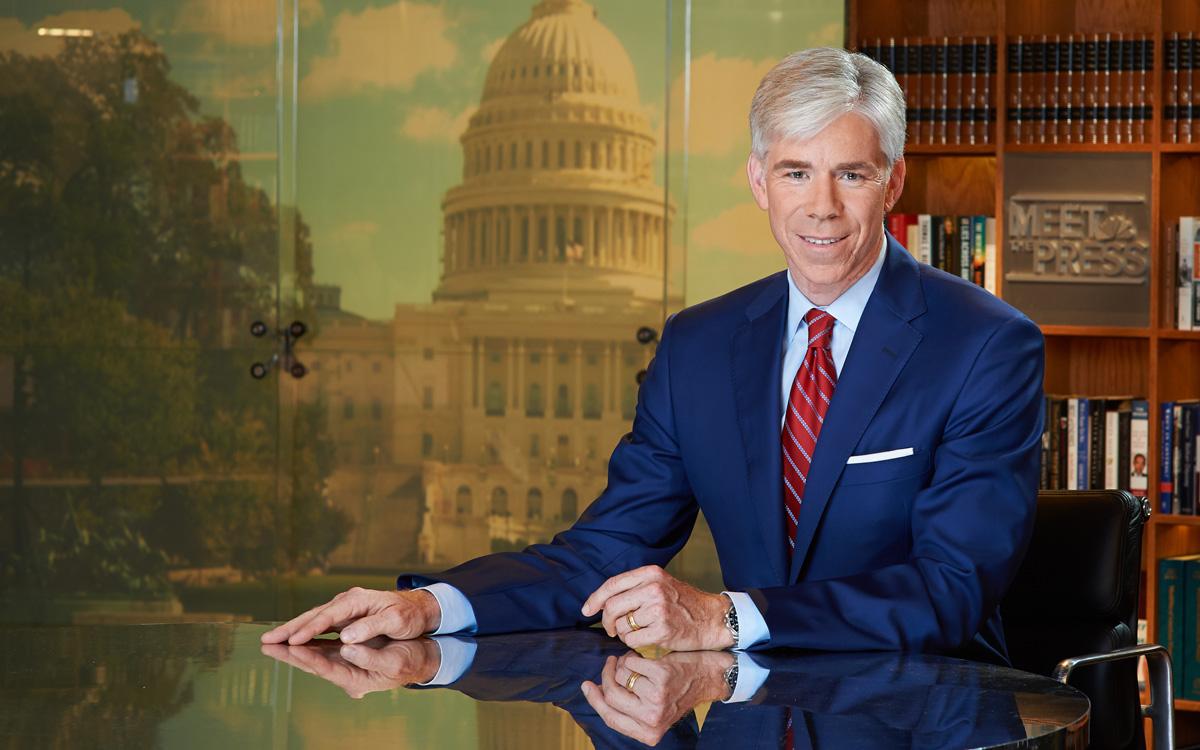
As the host of NBC News’ Meet the Press, David Gregory welcomes the biggest movers and shakers in politics every Sunday to go head-to-head on the issues of the day. The D.C. studio’s comfy library setting is a gentle frame for the heated debates that often go down here; discussions that Gregory must deftly moderate week after week and are a must-watch for anyone who cares about current events.
Gregory celebrates five years at Meet the Press this Saturday—he took the helm after long-time and beloved host Tim Russert passed away in June 2008—and has really extended the show’s conversations online, through his blog, Twitter, Facebook, Google+, Instagram and, now, Flipboard, where the Meet the Press team curates a magazine filled with articles relevant to guests on the show and news of the day.
We recently turned the tables on Gregory and put him in the interviewee seat to learn a bit more about the man who usually puts the spotlight on others. He told us about his journeys in journalism, the stories he feels aren’t reported enough today, and the hip-hop-fueled dinner/dance parties he has at his house.
~MiaQ
/flipboard
@flipboard
+flipboard
Scott Kleinberg is the Chicago Tribune’s social media editor, and he showed up as a surprise celebrity guest at last night’s Flipboard Flip n’ Sip event in downtown Chicago. Scott also leads the Chicago Tribune’s Flipboard curation team, so we have him to thank for creating all these amazing magazines.
When we met Scott last night, he mentioned that, totally coincidentally, he had just written an article about how to use Flipboard. And even more totally coincidentally, the article was scheduled to appear this morning. Sure enough, when we awoke in Chicago earlier today, there it was in the Tribune, for all to see.
Scott’s piece is called “How to Create Magazines Using Flipboard,” and in addition to explaining the basics of what Flipboard is all about, he also provides these useful pearls of Magmaker wisdom:
Why Flipboard? Why not just collect my tweets or save to bookmarks in my browser? With Flipboard, you can create a magazine called Social Media and flip content into it that you can share with others. I do that with all of these So Social columns, and you can find it here. And you can still share that magazine with all your favorite social networks.
The “subscribe” button is powerful. You use this button to add a magazine to your Flipboard. That means you get the update as soon as it happens. And you can and are encouraged to flip content from that magazine into magazines of your own. Think of that as the equivalent of a retweet. Flipboard will keep track of how many readers you have, how many page flips and how many articles.
Gathering magazine content is pretty easy. Click on the + button from within Flipboard when you see something you’d like to add to your magazine. Or, add the Flip It bookmarklet to your browser to grab content directly from the web. You can add your own content too directly from your most used social networks.
You control the cover of your magazine. From within Flipboard, just click promote to cover. My pro tip: Change the cover as often as possible. You wouldn’t buy a magazine with the same cover from your corner newsstand, right? You’d just assume it was old. The more colorful and eye-grabbing, the better.
What’s your name? Think about what you want to call your magazine. Remember that sometimes simple is best and encourages others to find it.
Categories count. Make sure you add yours to the correct category so people can find it when they search. And Flipboard spotlights their favorites from readers, so you never know when someone will find yours.
Check out Scott’s Flipboard profile to see his personal magazines, as well as the beautiful storytelling he’s doing with the Chicago Tribune on Flipboard.
Magazines We Love: Skillshare “Graduates” Editionhttps://in-id.about.flipboard.com/inside-flipboard/magazines-we-love-skillshare-graduates-edition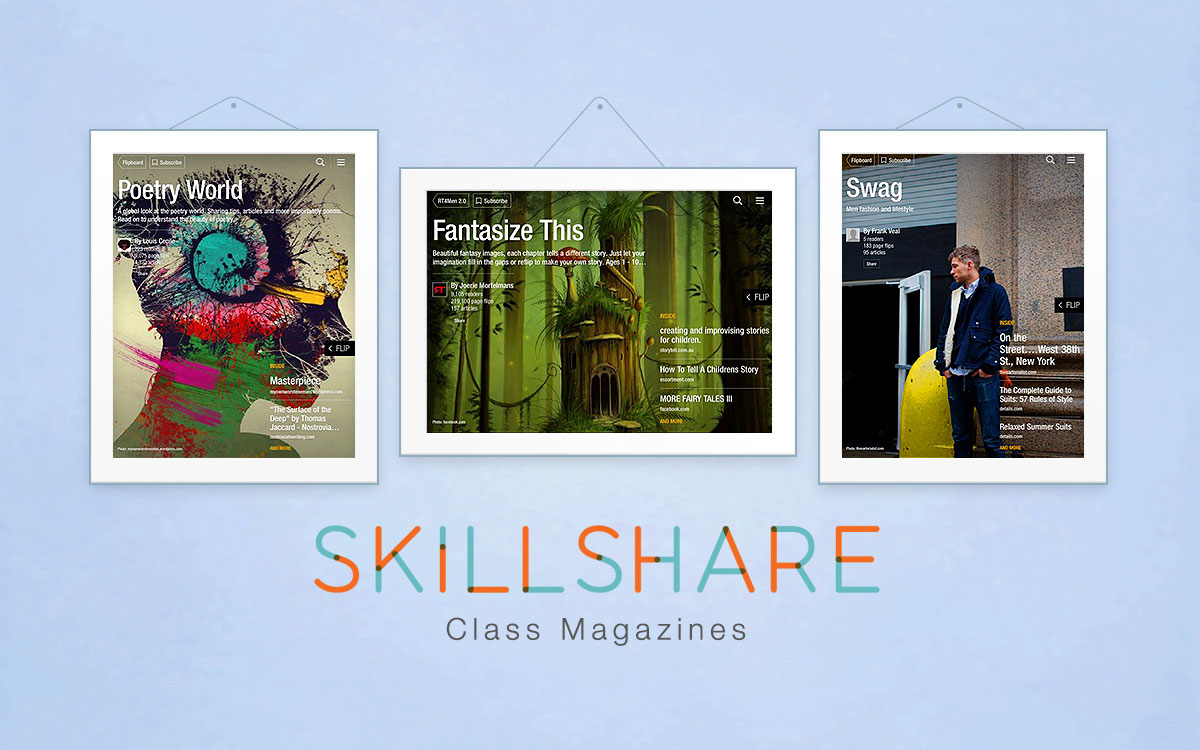
We’re teaching an online class right now at Skillshare called “Flip It! Make Magazines on Flipboard.†As part of the class, which kicked off on May 28, students create magazines around topics they’re passionate about.
More than 80 magazines were submitted to the Projects page by people from all over the world, and they covered everything from photography to parenting to Pompeii. Many curators told us their personal stories, like Nicole Greene, a mom who’s using social media to raise the profile of family in Trinidad & Tobago, or Victor Ioan Cernea, who’s making up for the fact that Flipboard is not localized for Romania by curating his own Romanian news magazine.
We enjoyed flipping through the submissions, offering tips when needed, and seeing curators help each other with solid advice and positive encouragement. While you can still enroll for the self-paced class, we thought we’d recognize the inaugural batch of “graduates†by featuring a dozen of our favorite magazines. You can find them now in the New & Noteworthy category in any English-language Content Guide or check out a sampling below.
Fantasize This by Joerie Mortelmans: The curator of the made-for-Flipboard magazine RT4Men has taken a radical new approach with Fantasize This, an image-based magazine meant to inspire young readers to make up their own stories.
Education, Technology & Blogging Tips by suewaters: Waters works at Edublogs, which provides blogs for educators and their students. Here, she brings her expertise helping teachers use technology into a magazine format.
The Fundraising Life by Marc A. Pitman: “I’m a fundraiser…and I love it!” declares Pitman. He directs that kind of passion into this magazine, which curates the best nonprofit fundraising advice on the web, as well as tips, tricks, and lifehacks for saving time, increasing enjoyment, and fully living life.
Poetry World by Louis Cecile: A poet and author, Cecile is using his magazine to share poetry, put the spotlight on unknown writers, and help poets find community on Flipboard.
All about Herbs by herbitat: This is a spot-on name for a magazine that covers a variety of topics related to growing and using herbs—and not just in food and drink.
My Neck Of The Hoods by Pearletta Wilson: This Londoner takes readers into her neighborhood of Hackney, with its vibrant street art and culture.
Thanks to everyone who participated in our class, and let us know if there’s a Flipboard-related class you’d like to attend.
Best,
~MiaQ
/flipboard
@flipboard
+flipboard

Making sense of the Internet is no easy task. It has puzzled journalists, industries and governments for the past few decades and continues to grow. (See video for more.)
The fine folks at Harvard University’s Berkman Center for Internet and Society have made it their mission to study the series of tubes and explain its effect on society. The center, founded in 2008, tackles such issues as net-neutrality, intellectual property and monopoly control while spotlighting thought-provoking studies of cyberspace.
~NajibA
/flipboard
@flipboard
+flipboard
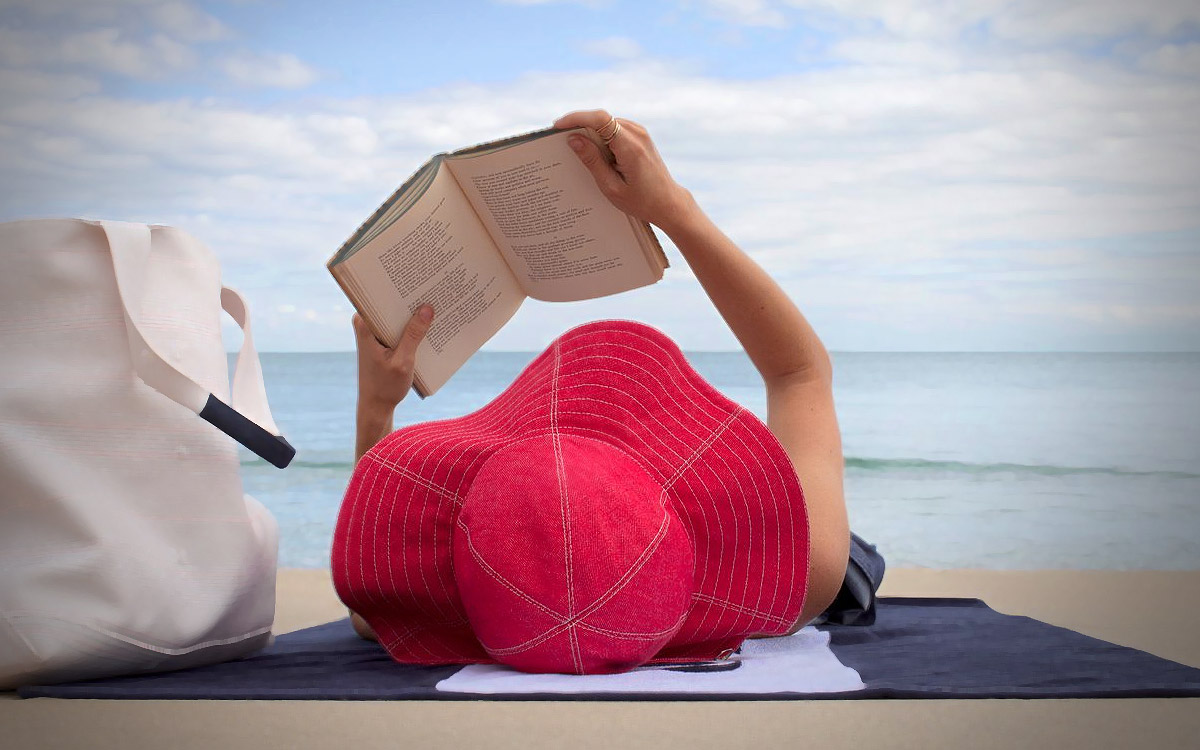
We hear many of you like to kick back with Flipboard on vacation. Tap on the red ribbon to open the Content Guide and in “This Week†you’ll see some reading recommendations for those lazy days at the beach.
Oprah: After more than a year’s hiatus, Oprah’s revered book club re-launched this summer as “Oprah’s Book Club 2.0†and vaulted into the digital age. Which means Oprah’s Flipboard section is also going heavy on literary fare (particularly in the next week), with pages that have been specially designed to showcase book content. Don’t miss “O’s 2012 Summer Reading List,†a 40-page gallery of buzzworthy reads.
The Rumpus: When Oprah decided to re-launch her book club, she chose a book, Wild, by Rumpus writer Cheryl Strayed, the site’s popular advice columnist. Strayed’s thoughtful column, “Dear Sugar,†is emblematic of The Rumpus’s editorial mantra: that what matters most is, simply, good writing. The online magazine eschews pop culture in favor of “regular culture‗ie, “books, art, films and music that doesn’t sound like everything else.â€
Longreads: Longreads and its community of curators are important propagators of long-form stories throughout the Web. Anyone can share a great piece of writing (typically over 1,500 words) by tagging tweets with #longreads. The Longreads team further winnows the recommendations and also showcases guest editors. The end result is a feed of articles guaranteed to be engrossing—and perfect for reading on-the-go.
Guardian Books: The Guardian Books franchise is a must for anyone who loves reading. The main section is filled with news, reviews, and discussion starters like “What are the best speed reads?†and “The world’s most difficult books: how many have you read?†There are also dedicated sections devoted to books for teens and kids.
Byliner: If there’s something happening in the world, tap on Byliner’s Flipboard feed to get a timely roundup of articles about that topic. For example, Byliner is already getting readers psyched for the America’s Cup, which is just around the corner, with a streamlined collection of sailing articles, from the last 35 years, from publications like Outside and the New York Times Magazine.
~MiaQ
/flipboard
@flipboard
+flipboard
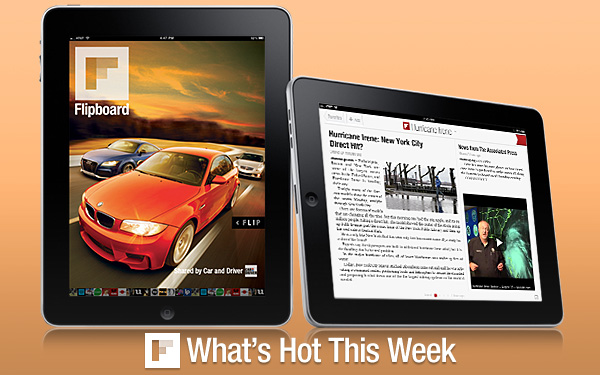
We’ve just updated the Content Guide with a slew of interesting magazines, blogs, and curators. There’s also a new section devoted to breaking news events. The first edition of our news section is devoted to tracking Hurricane Irene. We’re following key weather trackers and selectively retweeting essential items about the storm to keep you well informed.
This week’s highlights also include several feeds about driving, whether your speed is a $490,000 Aston Martin or a classic ’59 Harley or the latest line of Kona mountain bikes. And let’s not forget Byliner, a great new site that encourages the discovery of great writers and writing, and The Burning House, a new photo blog that features intriguing pictures of people’s most prized possessions. Flip on to find out more, and tell us about your favorite Flipboard reads in the comments.
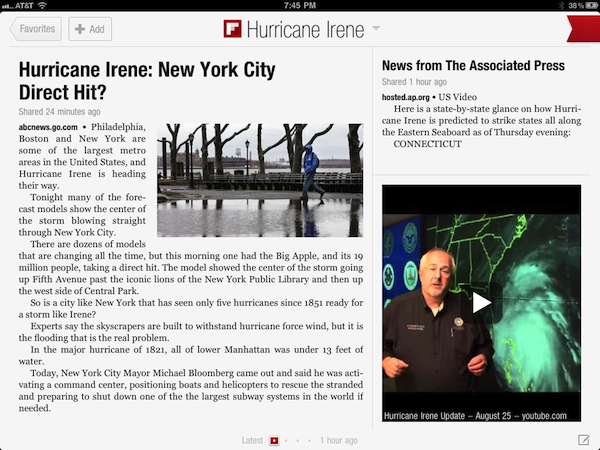
Hurricane Irene – Tap to Add Section
Add this section to your Flipboard to get a streamlined digest of the news about the storm heading toward the East Coast. It’s predicted to be a big one, and New York City has already announced a precautionary plan to shut down its public transportation system on Saturday.
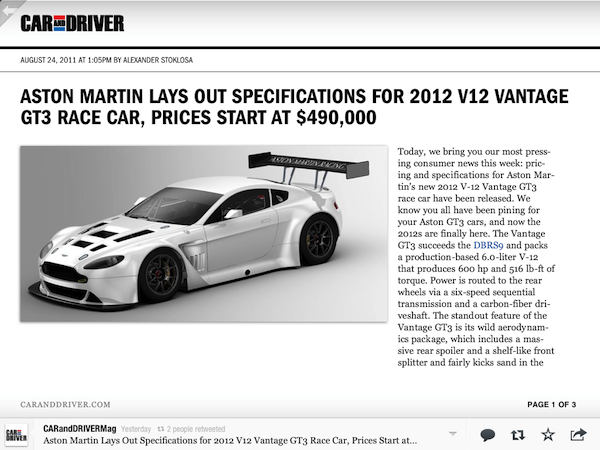
Car and Driver – Tap to Add Section
The world’s largest car magazine sits at the heart of the auto industry, offering news and reviews for true car enthusiasts. Go to C/D for tests of the latest models, “spy photos†of future cars, news from auto shows worldwide, and industry insight. Right now, there’s lots of news about 2012 models and even a peek at what’s in store for some 2013 editions.
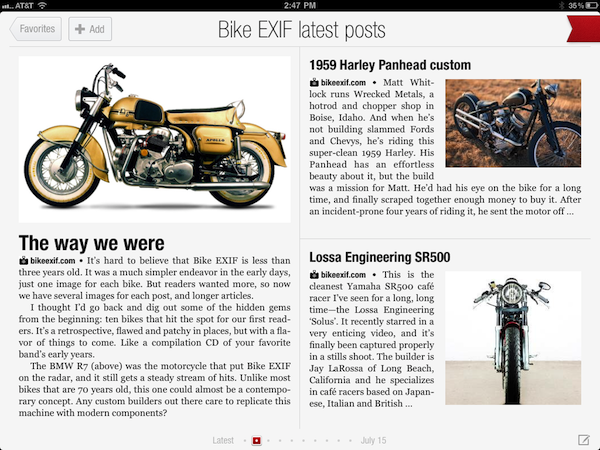
Bike EXIF – Tap to Add Section
Founder Chris Hunter is passionate about design and photography, as well as beautiful motorcycles. That’s why his site has appeal beyond the usual biker crowd. EXIF stands for ‘Exchangeable Image File format,’ the metadata captured by a digital camera when a photo is taken, and that’s the tipoff: Hunter only includes the very best photos on his site. Oh, in case you were wondering: Hunter rides a Moto Guzzi V7 Classic.
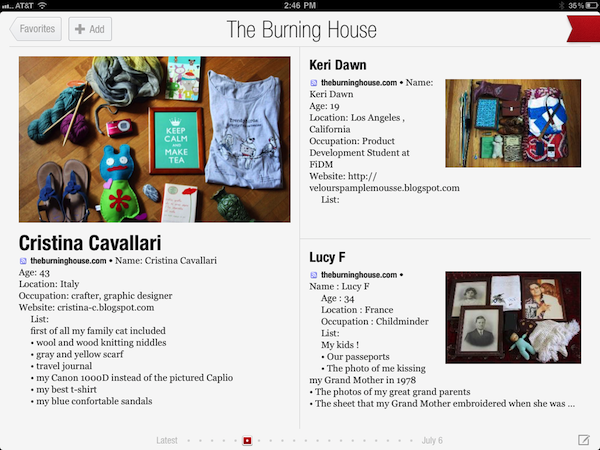
The Burning House – Tap to Add Section
The premise behind The Burning House is simple: if your house were going down in flames, what would you take with you? People from all over the world have responded to this question by submitting photographs of their most prized possessions. Each picture tells a powerful story — “think of it as an interview condensed into one question,†writes founder Foster Huntington. What’s more, the presentation of each photo is as interesting as the items pictured.
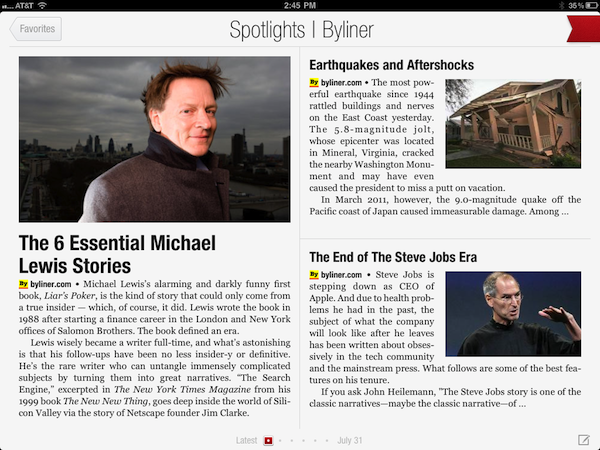
Byliner Spotlights – Tap to Add Section
Byliner pulls together the best feature articles ever written on a specific subject — for example, earthquakes, Michelle Bachmann, reality television, or the whipsawing Dow — and then adds context and insight. (Think: An instant and entertaining primer to every subject imaginable.) This unique feed, curated by the Byliner staff, offers timely and essential readings about the most interesting and important topics of the day.
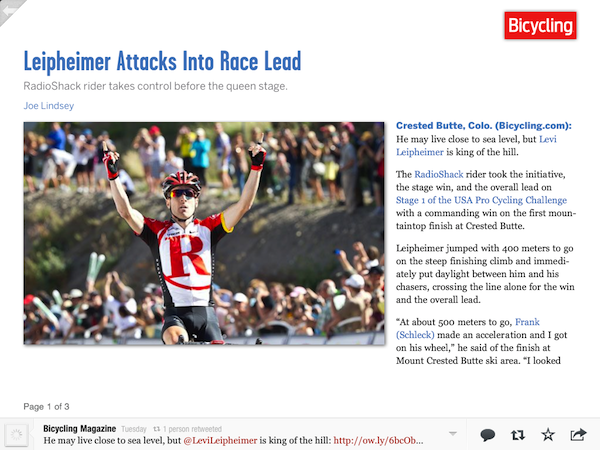
Bicycling – Tap to Add Section
Since launching earlier this summer, Bicycling Magazine has covered the Tour of Spain and the USA Pro Cycling Challenge in Colorado. Mixed in with all the pro action, everyday cyclists get tips on eating well, training smart, wearing the right gear, and even the best beers for post-ride refreshment.




